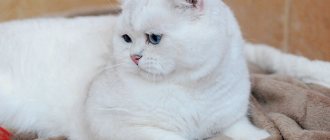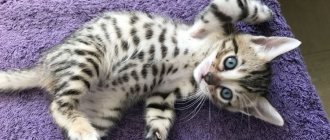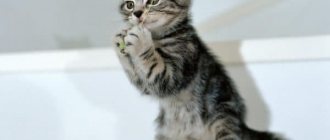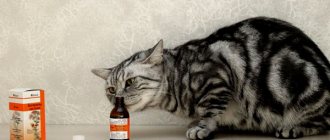8745Administration
When getting a pet, everyone understands that they will face a number of difficulties. However, few people think about the “mating season” of future pets. This topic deserves special attention; preparation is indispensable. So, what to do if the cat goes on a spree? The most important thing is not to panic.
It should be remembered that the animal senses the owner’s mood. Many people begin to think about how to get rid of the animal, because it is such a hassle. There is no need to show weakness, all problems can be solved. The main thing is to know how to do it. Having all the necessary information, you can help both the cat and yourself.
How long does sexual heat last and how often does it happen?
The cat's characteristic behavior lasts up to 10 days. The period when a cat is in sexual heat and allows a cat to approach her is called estrus. At this time, the ovarian follicles produce the maximum amount of estrogens and sex hormones.
In the very first days of estrus (1-4 days), the cat demonstrates sexual arousal, but does not allow mating. This time is called proestrus, “forerunner”.
If sexual intercourse does not occur during estrus, then ovulation does not occur. In this case, sexual heat returns every 10-14 days. The period between estrus is called interestrus, this is a time of rest for the uterus and ovaries. In some cats, the concentration of estrogen in the blood does not decrease, and the animal walks constantly. Prolonged heat is a sign of follicular ovarian cysts, which must be removed surgically.
Complete rest of the ovaries, which means the absence of the reproductive instinct, is called anestrus, the absence of estrus. In stray cats, this period occurs in late autumn or winter due to short daylight hours and the action of the hormone melatonin. Anestrus does not occur in domestic cats due to constant light and nutritious food.
The cat yells for the first time
The first desire to procreate in cats and female cats occurs at different times. Traditionally, cats begin to walk at the age of six months. Males go in search of their chosen one a little later - in the period from seven to eight months.
Often sexual activity begins a little later. Such a “shift” can be caused by the characteristics of the breed, living conditions, climate and other external factors.
In any case, puberty occurs early in cats. The pet begins to look for a mate while still a kitten. Therefore, the owner needs to decide in advance what he will do when the cat asks to “get married.”
The main question that arises before the owner: should kittens be allowed to appear or not?
If the kittens in the house are welcome guests, it is necessary to wait until the animal reaches full sexual maturity, and only then allow the pet to procreate. Therefore, veterinarians strongly recommend not breeding cats and female cats at their first request. Reproduction during the period of physical and mental development can lead to inhibition of this very development.
If the owner does not plan to breed kittens, it is necessary to decide what to do with the “walking” pet. This problem becomes especially acute when the cat begins to scream around the clock, exhausting everyone in the household mentally and herself physically.
Estrus without a “logical” conclusion causes a significant blow to the pet’s health, because during the “mating season” the animal refuses food and practically does not rest.
What doesn't help during heat?
What you definitely shouldn't do:
- Stroke the cat and pay attention to it: tactile contact only increases sexual arousal.
- Give herbal sedatives: the cat is not stressed and she is not nervous, she wants to reproduce. Owners can drink “Persen” with “Novopassit”; no herbs will affect the cat’s behavior.
- Use products with pheromones such as Feliway. They really help you survive the trip, get comfortable in a new place, and welcome a new family member. But they are expensive and absolutely useless during heat.
How long does a cat ask for a cat: cycle duration
How many days does this period last? Pet owners are also interested in how long a cat needs to take a walk. The number of days depends solely on the animal’s body. You can find out how long the heat lasts by simply observing the cat. As a rule, this process takes at least seven days.
In most cases this takes no more than ten days. But it all depends on the individual characteristics of the body. As stated above, it will not be possible to skip this period, since the pet will always remind the owner of its desires. But how often can this happen?
Not all owners want to “delight” themselves with fluffy balls that will appear a few months after the cat finds a male. Therefore, it is necessary to give the animal certain medications or sterilize it in time. After all, a cat, in principle, can go for walks very often. This may be repeated every three weeks or month.
Is there any way to help a cat during heat?
A feature of the reproductive system in cats is induced ovulation. Simply put, an egg is released from the ovary only in response to vaginal stimulation. Natural ovulation occurs 1-2 days after intercourse, and after another 1-2 days estrus stops.
Therefore, the owner can imitate sexual intercourse and thereby speed up the end of the cat’s estrus and torment. To do this, the animal is firmly grasped by the skin at the withers, and with the other hand, pressure is applied to the sacrum. When the cat moves its tail to the side, a suitable object is inserted into the vagina approximately 2 cm. This can be a thermometer with a soft tip lubricated with ointment or a cotton swab wrapped in latex. The procedure should be repeated several times within an hour, and then again after 12 hours. If the massage was successful, the cat begins to meow loudly and roll on the floor.
The onset of ovulation causes a false pregnancy. The estrus stops after a couple of days and does not return for 1-1.5 months. But this method cannot be used regularly, so as not to provoke inflammation of the uterus.
Duration of estrus
The length of a cat's cycle is determined individually for each individual. For the first time it can last 5-10 days, and sometimes reach 15-25 days and change as the hormonal balance changes. These indicators differ in animals of different breeds:
- Fold and British cats mature closer to a year, estrus lasts up to a week and occurs 3-4 times a year in Scottish cats, and no more than 2 times in British cats;
- in Persians, ovulation begins at six months of age, lasts 3-7 days and occurs quite often;
- in Bengal and Thai cats, puberty is most often observed from 6-8 months, cyclically once every 1-3 months, for 5-8 days;
- Siamese breeds and sphinxes walk 5-7 days every month, starting from a year;
- bobtails mature at 8-10 months, and in cats with medium hair there are 1-4 annual cycles of 4-6 days, and in short-haired cats - 6-7 of 10 days.
Six basic short theses about estrus in cats
- Puberty in cats occurs at 6-9 months.
- On average, estrus lasts a week and, in the absence of mating, repeats every 2-3 weeks.
- Behavior during estrus is largely determined by breed. There are cats that walk quietly and little. Others are literally climbing the wall.
- The only way to calm a cat is to induce ovulation with a special massage that simulates sexual intercourse.
- The use of hormonal agents or surgical sterilization should be considered before the onset of estrus.
- Repeated “empty” periods of sexual heat cause diseases of the genital organs - ovarian cysts, pyometra, hydrometra.
Publishing partner:
Signs that a cat wants a cat
How to determine that a cat wants a cat? With the onset of puberty, cats transform, becoming more courageous and strong. The growth of the skeleton, the enlargement of the skull and the acquisition of more rigid features are due to the constantly increasing level of testosterone.
The first signs of sexual heat are increased attention to smells.
Note! You may notice that the cat has begun to scratch door and window frames - this is one of the ways of leaving marks on the territory.
All domestic cats live in unnatural conditions, since they cannot mate according to the dictates of their instincts. A young, healthy, sexually mature cat can mate up to 10 times a day. That is why, even if there is one cat, all sexually mature females in the territory accessible to him will be fertilized during the period of estrus.
When a cat is locked within four walls, his sexual desire is constantly intensified. To attract females, the pet begins to scream loudly and intensively mark the territory.
Tags using glands that are located between the fingers and on the animal’s face are ineffective, because they are not attracted to the females’ home. Being under constant hormonal pressure, the cat begins to mark its territory with urine and sometimes feces.
Note! It is important not to confuse marks and ignoring the tray. When a cat marks, it approaches a vertical surface, turns its back, raises its tail, and sprays the surface with a stream of urine.
Particular attention should be paid to the smell. When a cat empties its bladder in the litter box, the smell of urine is strong, but not pungent. The tags have a very pungent, strong odor that is difficult to remove.
The next way a cat demonstrates its sexual activity is by leaving marks on the owner’s personal belongings. Sooner or later the pet will understand that there are females outside the home. To convey its messages to hypothetical mating partners, the cat will begin to mark the owner's shoes and belongings.
Note! It is worth considering that cats' sense of smell is much sharper than that of humans. When the windows in the home are open, and there are cats nearby that have entered into a state of sexual heat, the male senses them.
The pet will not deprive guests of “attention,” especially if they have pets. Shoes are especially at risk because they retain the smell of sweat. During the active phase, cats can become aggressive and fiercely guard the territory, especially from male animals.
What will help relieve anxiety?
The cat is going through a difficult period of heat. The owner also has a hard time, because he has to put up with the cries of his pet and her sometimes inappropriate behavior. It is impossible to breed an animal every time it is in heat, because pregnancy and childbirth undermine health and make serious adjustments to the way of life of all household members.
To relieve anxiety, it is recommended to do the following:
- isolate the animal, providing food, water and toilet;
- play slow classical music;
- mix sedatives into food;
- use hormonal drugs.
You should not use sedatives or hormonal drugs without consulting a doctor. The veterinarian will help you choose an effective medicine and prescribe the dosage.
If you do not consider the option of your pet having offspring in the future, use sterilization. The operation is performed once in a lifetime, usually after childbirth, and removes once and for all all the symptoms associated with estrus. The animal's life is extended. In addition, it is believed that a sterile pet is less at risk of developing cancer. However, it is worth remembering that it will not be possible to restore fertility to a cat after surgery.
If you are not ready for surgery, take advantage of advances in pharmacology. Among the effective sedatives are the drug “Cat Bayun”, catnip and drops “Fitex”.
If the cat asks for the cat, remain calm. Think about the fact that your pet will go into heat in 7 days. It is in your power to help her survive this period in the most comfortable environment possible.
Preparation for mating
Preparation is necessary to ensure that everything goes smoothly and without unnecessary problems. There are some tips for preparing cats and female cats for mating .
Owners of females should worry about searching for a male in advance, especially if they have purebred pets. In advance, before the start of the process, both parties prepare veterinary passports and documents confirming the origin and pedigree, and an agreement.
3-4 weeks before mating, the cat must be examined by a veterinarian; based on tests, he will issue a conclusion about the presence of infectious diseases; vaccination will also be carried out, if necessary.
Two weeks before the process, deworming is carried out. The animals' claws are trimmed within 2-3 days. The cat is not bathed to preserve its natural scent.











